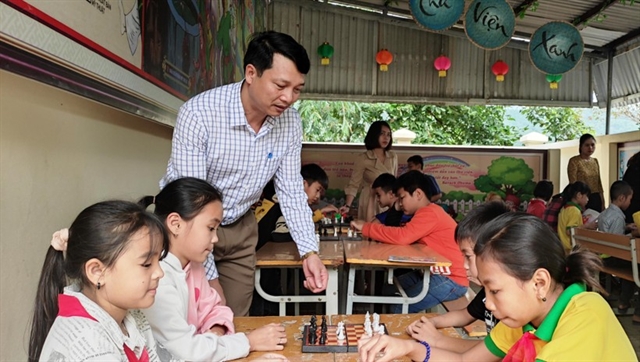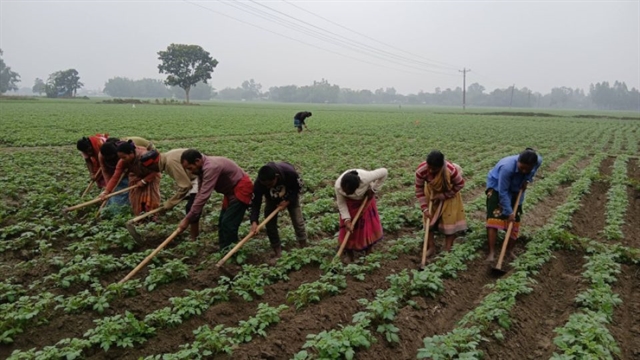 Society
Society

 |
| Teacher Đặng Xuân Viên instructs students on how to play chess at the school's green library. — Photo giaoducthoidai.vn |
THANH HOÁ — A teacher has devoted his career to poor ethnic students in the remote and difficult border area of Thanh Hoá Province.
He is Đặng Xuân Viên, the headmaster of Thanh Xuân Primary School in Quan Hoá District.
“As I remember it, there was directive No. 287-CT, dated 4/8/1992 issued by the Chairman of the Council of Ministers (now the Government) on a number of urgent issues in education and training. Accordingly, the 1992-1993 school year was the first year that Thanh Hoá Province's education sector started to send teachers to all ethnic villages in order to build schools and to implement the policy of universalising primary education and gradually eradicating illiteracy,” Viên told Giáo Dục và Thời Đại (Education and Times) newspaper.
In September 1992, he and a colleague named Đỗ Quang Bằng were assigned to teach at Trung Lý Secondary School in the mountainous district of Mường Lát where the majority of the population are ethnic minority people.
“So it has been 30 years,” Viên recalled.
“In those days, we newly-graduated students, with youthful energy, enthusiasm and optimism, were more than happy to accept the task,” said the teacher.
“I was assigned to go to the ethnic villages of Trung Lý Commune to encourage Mông minority children to go to school and learn,” he said.
At that time, Trung Lý Commune was a place where malaria still ravaged, killing hundreds of people per year.
“About half a month before we arrived, Đỗ Xuân Thơm, vice principal of Trung Lý Secondary School, had passed away from the disease,” he said.
Sad memories
Those were extremely difficult years.
When talking about his colleague - teacher Đỗ Quang Bằng - Viên seems to touch an unforgettably sad memory.
“I was infected with malaria and got hand muscle inflammation after three months in the commune. Then I was transferred to the hospital in Quan Hoá District for treatment,” Viên recalled.
So Bằng and two other teachers were assigned to ethnic Tài Chánh Village to teach the first and second-year classes.
They had to walk 45km through the forest from the main school to Tài Chánh Village.
In the village, local people built two makeshift cottages with palm leaves to make classes and accommodation.
After setting up classes and mobilising students, the teachers walked back to the main school site to receive textbooks and school supplies for students.
“I was told that on the morning of September 22, 1992, the three teachers each carried on their backs about 20kg of textbooks, notebooks and other school supplies to Tài Chánh Village,” Viên said.
“At that time, it was the rainy and stormy season so the water of the Mã River surged up ferociously. The teachers and a boatman on a small canoe crossed the river at the wharf of Cò Cài- Tài Chánh,” he said.
“The boat was near the middle of the stream, and the waves were so big that people and luggage were all wet. Protecting colleagues and school supplies for students, Bằng was not afraid of jumping into the fast water to try to swim to push the boat. However, due to the fast water, he was swept away. And his body was found after 20 days,” he sadly recalled.
Donation for poor students
In 1996, Viên was transferred to Quan Hoá District.
After teaching in many schools in remote areas, in 2008, Viên was appointed principal of Quan Hoá Primary School.
Viên and his colleagues worked hard to build the school up to national school standards.
Until now, this is also the first and only national standard school in the district.
Ten years later, Viên was transferred and appointed principal of Thanh Xuân Primary School.
Thanh Xuân is one of the remote and extremely difficult communes of Quan Hoá District.
At that time, the school facilities were very poor. The school has six other classes scattered in ethnic villages where travel is very difficult through mountainous terrain, rivers and streams.
During the rainy season, the water level of the Mã River and streams rises quickly and roads are eroded, endangering both teachers and students.
“The students are 98 per cent of Thái and Mường ethnic groups. People live mainly by growing bamboo which brought low incomes. Therefore, most families were very poor,” Viên said.
Most children live five to six kilometres from the school. Every day, they have to cross the Mã River by boat to the school.
When the hydroelectric power plants discharge water or during flood season, the Mã river rises very dangerously.
Moreover, most of the children's parents work far away. They just come home during Tết holiday. The children have to live with their grandparents or relatives, so it is impossible to pick them up and drop them off every day.
So, the principal always thinks about setting up a semi-boarding school with school supplies, food and accommodation so that students can stay to learn long term and their parents will feel secure sending their children to school.
That is a burning dream of the teacher who has spent more than 30 years teaching in mountainous remote areas.
To realise the dream, Viên went out to ask organisations, individuals, and friends to build a kitchen and houses for his students.
“The journey to have meals for students has just begun and I know there are still many difficulties and obstacles, but I believe that everyone will support this work,” Viên said.
When he was assigned to work in the mountainous area, he promised his mother that he would only work for a few years, then move back to take care of his parents.
However, after 30 years, he still could not fulfil his promise to his mother.
“Now I have decided to try to take care of the students in this difficult land. Here, after all these years of working, it is already like my hometown," said Viên. — VNS




